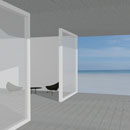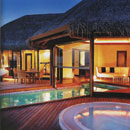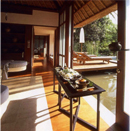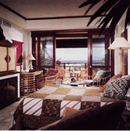
Transactional Space
Transactional Space describes the area between interior and exterior that is blurred by continued flooring materials and often dematerialized walls between spaces—a spatial device extending the interior into the exterior and the exterior into the interior. Transactional Space is derived from traditional Japanese architecture. more
Transactional Space | Resort & Spa
application
In resort and spa facilities, Transactional Space constitutes a seamless flow from interior guestrooms and treatment rooms to exterior gardens.
research
In Japanese architecture, the term noki-shita is synonymous with transactional space as it translates literally to a “sphere under the eaves, which is the space for climatic, visual, and social transactions.”1 This ‘sphere’ is traditionally protected by a roof of generous proportions, shielding individuals from the elements. Partitions placed within the transactional space are translucent and removable, so that there is an unmarred flow between the interior and exterior zones. In Eastern buildings, shoji screens with translucent paper planes are common dividers; translucent glass and bamboo blinds are utilized by both Eastern and Western cultures.
Grand resort hotels of the late 19th century often featured deep verandas that enveloped the body of hotel buildings.2 While bungalow porches may seem synonymous with noki-shita, they differ chiefly in the meaning of transactional space. Although verandas and porches are semi-exterior spaces between the inside and outside of a house, they lack the attention to ventilation and light that traditional Japanese architecture exhibits. Furthermore, porches are generally barriers designed to separate public areas, such as roads, from private interiors.
Transactional space is a unique entity that acts as a zone of repose between the garden and the house, entitled en-gawa.3 Often shielded from public eyes by strategic landscaping, en-gawa is a private moment for the resident or patron.
While some resort and spa establishments employ an obvious Japanese design concept, conveyed through tatami mats and shoji screens, most have incorporated the notion of transactional space into their overall design scheme. Some locales, such as the Huvafen Fushi Resort (2005) in the Maldives and the White Pond Resort and Training Center (2004) in Baiyangdian, China have reinterpreted transactional space as an experience of immersion in water; a narrow pool connects the interior living space to the exterior lounge space.
In resort and spa facilities, transactional space is a seamless flow from interior guestrooms and treatment rooms to exterior gardens. Because of the typical lighting levels of spas—glaring exteriors and dim interiors, transactional spaces serve to “provide the necessary time for the photoreceptors in the retina to adjust from one condition of brightness to the next.”4 This gradual change in lighting enables the guests to physically and mentally adapt to their surroundings, as furnishings are of a similar vocabulary and the flooring, be it wood, tile, or concrete, is consistent throughout. The translation of transactional space in resort and spa facilities imparts a sense of seamlessness between exterior and interior, stress and relaxation.
end notes
- 1) Gunter Nitschke, “En-Transactional Space,” From Shinto to Ando: Studies in Architectural Anthropology in Japan (London: Academy Editions, 1994), 85.
- 2) Jeffrey W. Limerick, “The Grand Resort Hotels of America” Perspecta 15 (1975): 92.
- 3) Nitschke, “En-Transactional Space,” 87.
- 4) Lou Michel, Light: The Shape of Space, Designing with Space and Light (New York: Van Nostrand Reinhold, 1996), 164.
- 5) Evidence for the archetypical use and the chronological sequence of Transactional Space in resort and spa was developed from the following sources: 1950 Lobby, Caribe Hilton Hotel [1950] Toro, Ferrer, Torregosa; San Juan, Puerto Rico in "The Caribe Hilton," Interiors 109, no. 9 (Apr. 1950): 76; PhotoCrd: Ezra Stoller / 1960 Guest Room, The Palm Springs Spa Hotel [1964] William Cody, Architect; William Pereira and Associates; Palm Springs CA in "Contract Giant: Parvin/Dohrman," Interiors 123, no. 7 (Feb. 1964): 99; PhotoCrd: Anonymous / 1970 Guest Room, Tres Vidas en la Playa [1971] Valerian Rybar, AID, Interior Design; Acapulco, Mexico in "Tres Vidas en la Playa," Interior Design 42, no. 10 (Oct. 1971): 119; PhotoCrd: Alexandre Georges; Guest Suites Terraces, Hotel LaSamana [1974] Robertson Ward, Architect; Nicole Frankel, Interior Design; St. Martin, U.S. Virgin Island in James Wilson, "Sun in the Caribi-terranean," Interiors 134, no. 3 (Oct. 1974): 73; PhotoCrd: Hiro / 1980 Guest Room, Four Seasons Wailea Beach Palace [1991] WATG and James Northcutt Associates; Wailea Beach, Hawaii in "Four Seasons Wailea Beach Palace," Interior Design 62, no. 9 (June 1991): 149, 152; PhotoCrd: Jaime Ardiles-Arce; Guest Room, Four Seasons Resort at Sayan [1998] Heath and Company; Bali, Indonesia in "Destination Architecture," Architectural Record 186, no. 11 (Nov. 1998): 125; PhotoCrd: Rio Helmi/INI / 2000 Guest Room, Le Saint Geran Hotel [2001] Ridler Shepard Low and Macbeth Architects and Designers; HBA Hirsch Bedner Associates, Interior Design; Belle Mar, Mauritius Island, Indian Ocean in Kelly Beamon, "Le Saint Geran Hotel," Hospitality Design Magazine 23, no. 8 (Nov. 2001): 106-107; PhotoCrd: Dan Ham; Guest Room, Oberoi Mauritius Resort [2001] Bunnag Architects; H.L. Lim, Interior Design; The Pointe aux Piments, Mauritius in "Mystical Appeal," Interior Design 72, no. 8 (June 2001): 206; PhotoCrd: Oberoi Group; Guest Room, Grand Velas All Suites and Spa Resort [2002] Elias and Elias, Architect; Roberto Elias and Melin Castro, Interior Design; Nuevo Vallarta, Mexico in Holly Gordon, "Mexico Mellow," Hospitality Design Magazine 25, no. 5 (July 2003): 59; PhotoCrd: Letcia Alarcon; Guest Room, White Pond Resort and Training Center [2004] Leo A. Daly Pacific, Architect; Christo Leung, Interior Designer; Baiyangdian, Hebel, China in Jorge S. Arango, "Elements of Style," Hospitality Design Magazine 26, no. 6 (Aug. 2004): 74-76; PhotoCrd: Stuart Woods and T.L. Leung; Guest Room, Hilton Sanya Resort and Spa [2005] Wimberly Allison Tong and Goo (WATG); Sanya, China in Paul Rusnak, "China Beach," Hotel Design Magazine (Oct./Nov. 2006): 14; PhotoCrd: Hilton Sanya Resort and Spa.
bibliographic citations
1) Goldfarb, Rachel. “Theory Studies: Archetypical Practices of Contemporary Resort and Spa Design.” M.A. Thesis, Cornell University, 2008, 24-30.
2) The Interior Archetypes Research and Teaching Project, Cornell University, www.intypes.cornell.edu (accessed month & date, year).



